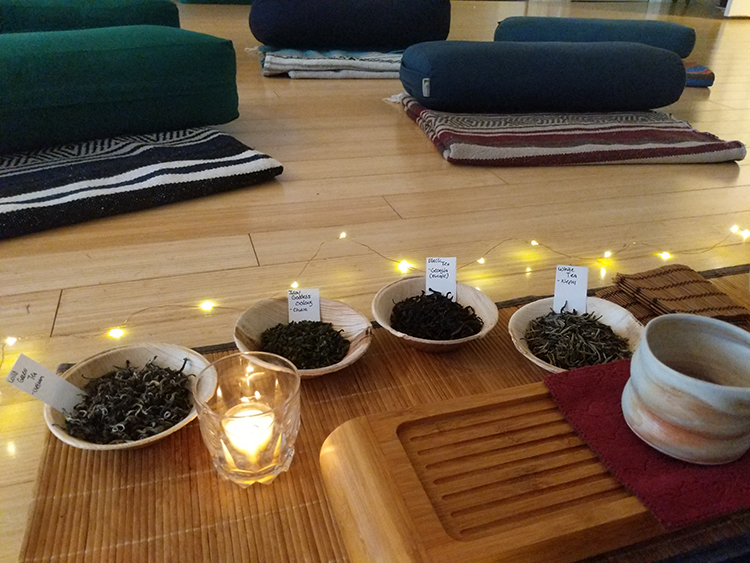
I started to feel something stir within my tea quite some time before I actually worked in tea professionally.
Around 2001 or 2002, I took up the pleasant habit of taking an afternoon break with tea on the patio at my work. In my life before tea, I worked in a newsroom, producing newscasts and writing stories for shows. I lived in Las Vegas. As you might imagine, this was indeed a rather tense and stressful job, to put it mildly. About an hour before the show, I would take some time alone to sit outside and drink tea quietly.
Back then I only had access to tea bags. Carefully, I would tear them open just a little to release some of the tiny leaves inside, and I would observe how they moved in the water. I could also see how they flowed and moved beneath the infused paper. Their small, flattish shape and bright color struck me as similar to the leafy canopy overhead, if I concentrated my sight on the very top leaves of the tree.
There was a connection – green life in my cup, green life above in the branches.
As the warm, late afternoon desert breeze rustled around the leaves and branches, the tea in my cup moved to its own motion in the water. Soothing, rhythmic, yet somehow also distinctly still and quiet. At the time, I had no vocabulary for this experience or state of mind. I only knew that it helped me when it came time to step into the control room and go live.
These early experiences stuck with me for some years, until I found tea again – this time, for keeps.–
The Way of Tea
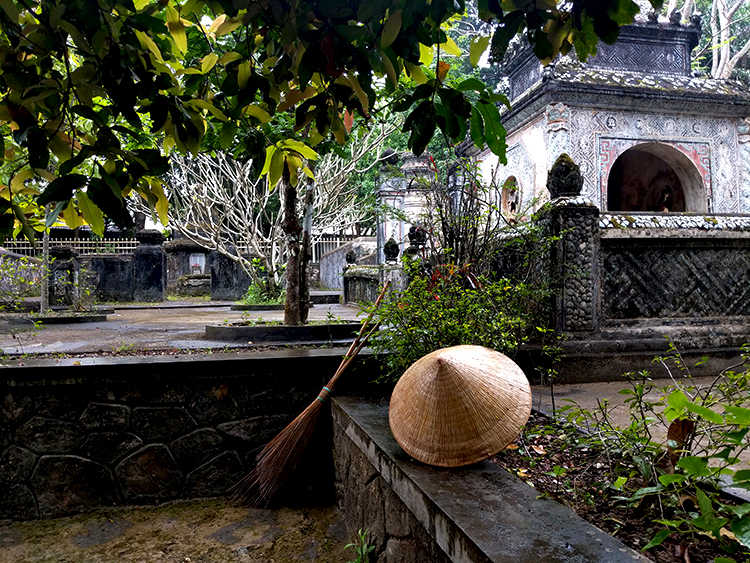
There is a popular quote amongst tea practitioners in Japanese traditions: “The taste of Tea and Zen are one.” This opens the door to an understanding that earnestly practicing tea, with your whole mind and heart, is equal effort to time spent on a meditation cushion. Tea is about abiding in the present moment, witnessing the reactive mind, and calmly learning to accept and be with what is. Such ideas are not limited only to Japan’s teachings and history, but can also be found at the core of intentional tea living and tea sharing throughout Asia, including China, Korea and Vietnam.
To offer the simplest explanation, tea is considered a “Way” (dao), a path of deep study or devotion that carries you in this life. Tea is one of many such traditional Ways that one might practice, in this line of thinking. And there really is that much to learn from tea – more than a lifetime. Note this is not referring to technical, industrial or academic knowledge; this is the study of how tea is an expression of inter-being and inter-relationships. Relationship between Self and Tea, as well as Self and others when preparing and serving tea, and in time, seeing that there really are no lines between any of these. Understanding any of this in a viscerally felt level all takes time, and so, it is a Way. You live it, like yoga.
Pema Chödrön, an American Buddhist nun of Tibetan lineage, says, “The essence of meditation is training in something that is quite radical and definitely not the habitual pattern of the species: And that is to stay with ourselves no matter what is happening, without putting labels of good and bad, right and wrong, pure and impure, on top of our experience.” This can be practiced with every cup of tea we make with intention. Thich Nhat Hanh (or “Thay” to his students, which means teacher), a Vietnamese Zen monk I draw much inspiration from, teaches that every activity of our waking life – washing dishes, peeling an orange, walking to the bus, and yes, drinking tea – can also be a living meditation.
The intended roots are worth pointing out specifically because for the many people interested in – and perhaps struggling with – practices of meditation or mindfulness, it’s helpful to know that there are actually many ways forward in such an endeavor. Tea is one of them.
Living Meditation in Stressful Times
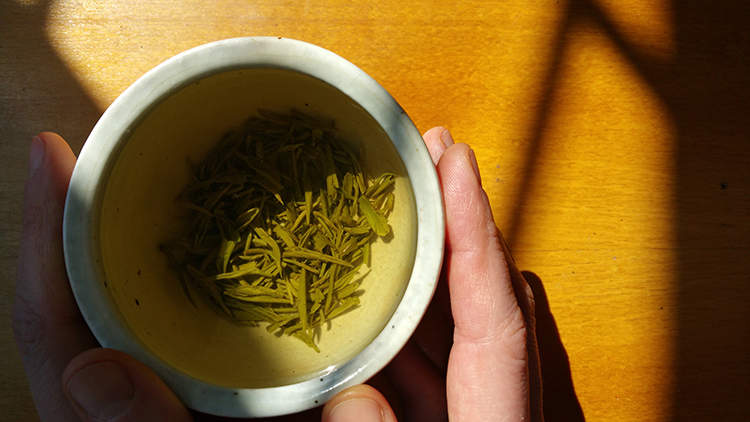
From a psychologically and trauma sensitive point of view, this is crucial for modern living, as there are so many people suffering under unbearably high levels of stress, trauma and also chronic pain. Feeling disconnected from the body is a common complaint. About 80 percent of visits to primary care doctors have a significant, stress-based component (Avery, 2003, Journal of the National Medical Association). Meditation has been shown to reduce stress, ease depression, and improve immune functionality, and that’s just a modest start. But for any number of very real reasons – chronic pain, anxiety, previous exposure to trauma – sitting in rigid stillness with folded legs and shut eyes is simply not an accessible, appropriate or supportive method for all people.
The answer is not to try harder in a manner that is not serving – it’s to try to practice in a way that helps us feel safe and supported. Notably, Thay says, “Applying non-violence to your body is not merely a means to practice mindfulness – it is a practice in itself.”
Neuropsychologist Rick Hanson PH.D and neurologist Richard Mendius MD explain, “Deliberately feeling safer helps control the hardwired tendency to look for and overreact to threats.” Without an ability to feel safe while living under sustained stress, this vigilance against possible threat can easily become a constant, crippling burden.
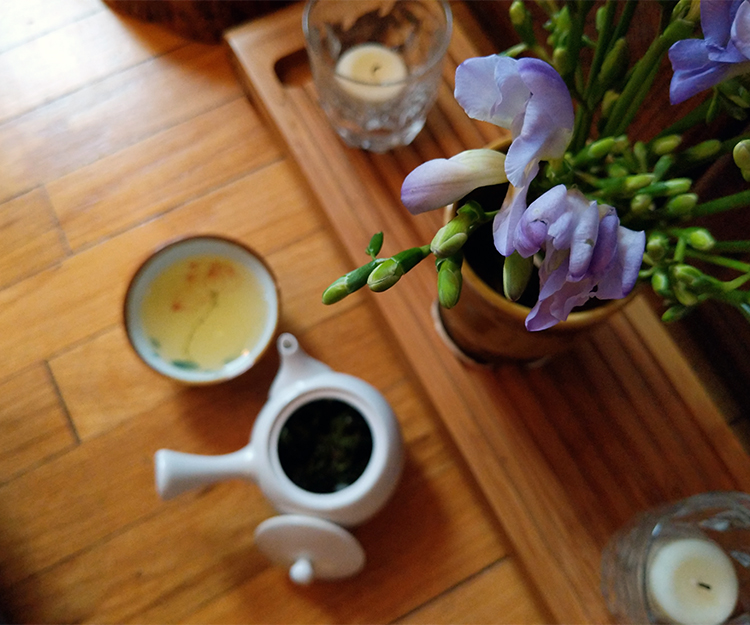
To work through this, we can focus on nurturing the antidote to negativity (gratitude) and deliberately creating safety. Intentional acts of creating safety can include physically relaxing the body, using positive imagery, and finding refuges in people or places. “As you rest increasingly in a background sense of refuge, neurons are quietly stitching a safety net for you.” (Hanson & Mendius)
Drinking tea during a meditation session can be a safe harbor, where you can use your full senses to reconnect, explore and understand yourself and soothe your reactions. The dedicated portion of time is the safe harbor, as is the physical place you create for the practice. Tea becomes a way to welcome you home again to body and mind. A place where you can touch gratitude. Here, you experience tea as though it is the first cup you’ve ever really had, opening the heart to other possibilities that clear-eyed mindfulness can bring.
Meditation WITH Tea
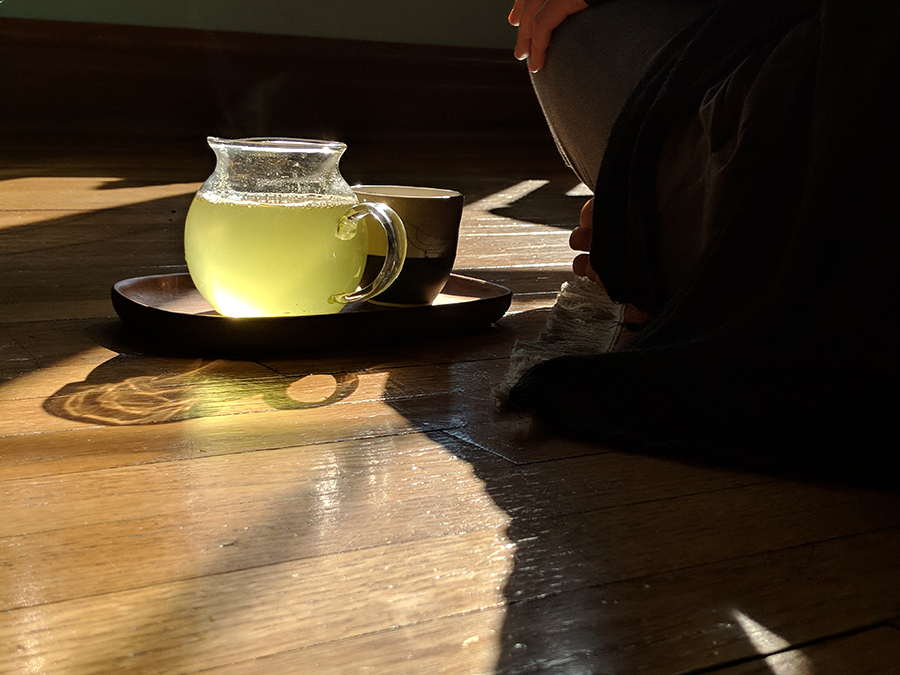
It starts with bringing intention to the tea you wish to sit with today, and how you will prepare it. Finding a space where you can sit comfortably and uninterrupted. Taking time to really notice each step that you’re taking with your tea.
Placing the leaves carefully inside the pot, hearing the soft crinkling noise they make as they are set down. Pause.
Enjoying how the sound of the kettle shifts in rumble and pitch as the temperature rises slowly. Observe any note of wanting the kettle to go faster, or mentally skipping ahead to imagine yourself drinking tea. Pause to practice non-judgment.
The steam that unfurls in whispy curls as water is poured over the leaves, releasing the faintest of sounds and the most fragrant of aromas. Pause and observe these quiet offerings as they fade into the air.
The feeling of patience as you sit and wait, calmly with your hands at complete rest, for the tea. Pause and notice any flickers of future thoughts or past ruminating, calmly setting them aside.
The bright, cheerful noise of tea being decanted, flowing from pot to cup. Pause and notice the echo that lingers.
The deep warmth seeping into palm and finger muscles as you curl your hands around the cup of tea. Pause and touch gratitude.
Warm breath coming in with your inhale, tension releasing on your exhale. Pause between inhale and exhale, feeling your breathing muscles.
The tea bringing softness and opening with every sip. Pause and be with the tea.
Just… sit.
Observing.
Learning to just accept and “not do.” Not doing is really challenging work, but it’s so worth it!
A session might last 10 minutes with one cup, an hour or an entire morning with several cups, just depending on what is best for you today.
You Are Enough
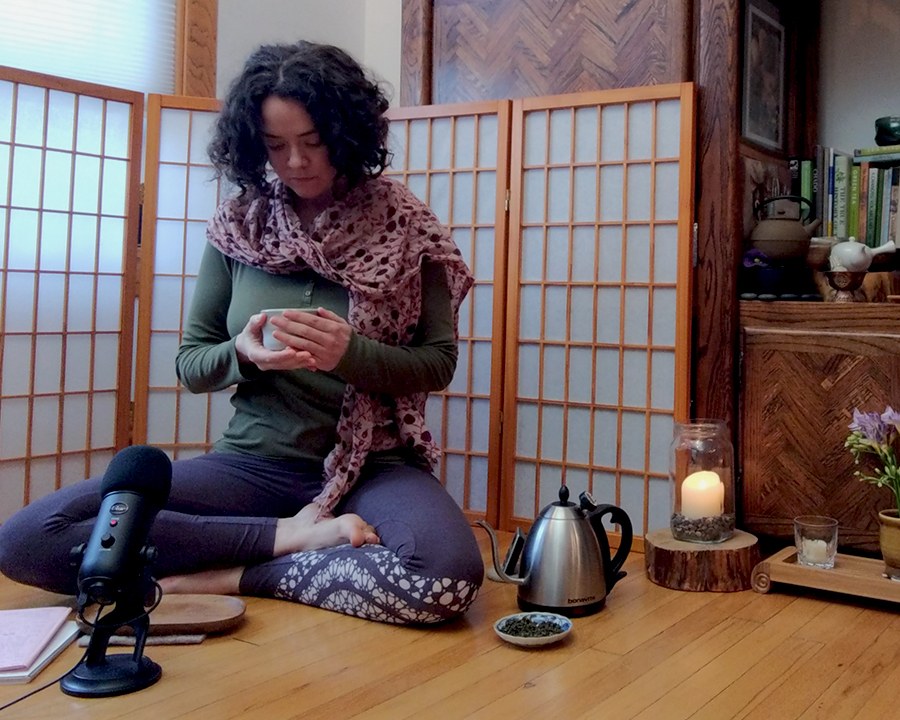
In time, new connections start to form in our brain, consciously and subconsciously, as we simply gaze at gently unfolding, releasing tea leaves in water. Connections that signal to our nervous system that it can let go right now. Release. When we sit with tea, we actually imbibe a manifestation of release ourselves. We become one with the tea, a reflection of your unspoken self. Watching at the slowly unwinding leaves, we also learn how to apply these metaphorical observations in our daily life. How can we become more abiding and patient, yet gently persistent, like the tea?
Most importantly, when we sit with tea and experience all the countless ways that every cup, no matter how different from steep to steep or day to day, is always just what we need, we learn this: There’s no need to try so hard that we break ourselves. Tea helps you see that you are always enough, just as you are now.
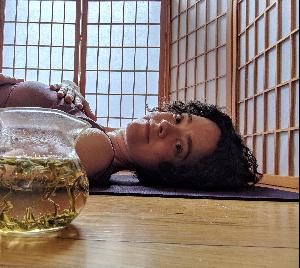 Suzette Hammond is the founder of Being Tea, an education-focused private practice offering skills training, custom workshops and project development for tea programs. A professional trainer and tea taster, as well as tea spiritual practitioner, Suzette has been deeply involved in the US tea industry for more than 15 years. Her background is a blend of disciplines: She is a trained journalist, tea ceremony student, teacher of tea mindfulness, advocate of tea practice for mental health, and a student of somatic movement therapies such as Alexander Technique. She is also a soon to be certified psych-sensitive and trauma informed yoga teacher. In 2018, Suzette was honored with a World Tea Award for Best Tea Educator. You can find her at beingtea.com or on Instagram at @beingtea.
Suzette Hammond is the founder of Being Tea, an education-focused private practice offering skills training, custom workshops and project development for tea programs. A professional trainer and tea taster, as well as tea spiritual practitioner, Suzette has been deeply involved in the US tea industry for more than 15 years. Her background is a blend of disciplines: She is a trained journalist, tea ceremony student, teacher of tea mindfulness, advocate of tea practice for mental health, and a student of somatic movement therapies such as Alexander Technique. She is also a soon to be certified psych-sensitive and trauma informed yoga teacher. In 2018, Suzette was honored with a World Tea Award for Best Tea Educator. You can find her at beingtea.com or on Instagram at @beingtea.
 Click here to see all the articles in the Health & Wellness Issue
Click here to see all the articles in the Health & Wellness Issue